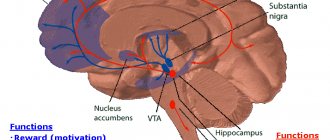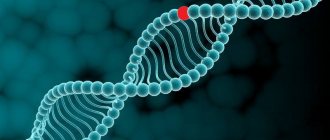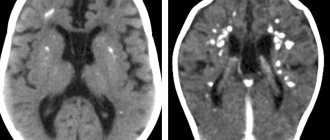Literally translated, the term “depersonalization” means the depersonalization or disappearance of one’s own “I.” Sometimes the concepts of mental alienation or anesthesia are used to describe this illness in psychiatry. It is characterized by emotional detachment in relation to anyone or anything, including oneself. The disorder is very difficult to treat and always requires careful diagnosis and constant medical supervision even during remission. But the specialists of the Leto mental health center know perfectly well what to do even in the most difficult cases, and how to achieve a positive result in the vast majority of patients.
Causes
The etiology of the disease may be associated with:
- severe stress, especially at an early age;
- episodes of physical violence;
- hereditary predisposition, but in such cases the chances of curing depersonalization are low, since the symptoms gradually develop into schizophrenia;
- pathologies of the central nervous system, in particular epilepsy, but if the cause of the disorder is neurological diseases, the occurrence of a state of “already seen” (deja vu) or “never seen” (jamais vu) is typical.
Clinical signs
Depersonalization-derealization syndrome as an independent disorder is extremely rare; usually such a condition accompanies schizophrenia, some forms of psychosis and other somatic and mental illnesses. Symptoms manifest in adolescence and young adulthood (15–30 years), women are more often affected.
With depersonalization syndrome, the patient is aware of the changes occurring in his psyche and experiences them painfully (at least in the initial stages). Usually in everyday life, everything that surrounds a mentally healthy person is perceived and viewed by him as something familiar, understandable and completely explainable. Certain elements of the environment are used to satisfy biological and spiritual needs. With depersonalization-derealization syndrome, alienation occurs both from the surrounding world and from one’s own personality.
At the initial stage, the feeling and awareness of one’s body and the world around is lost. Perception loses its naturalness, liveliness, and spontaneity. The patient constantly experiences psycho-emotional discomfort, ponders the correctness of statements on this or that matter, and subjects all his actions to scrupulous analysis.
Depersonalization disorders are radically different from a person's previous experiences. Often the patient does not have enough words to describe them, which forces him to resort to various metaphors; sometimes his own terminology appears with which he describes the sensations. Statements are in the nature of assumptions, therefore in speech they constantly use comparative phrases and expressions (as if, as if, it seems, etc.).
Diagnostics
Diagnosis is most difficult with the first type (at the first stage) of depersonalization. It should be noted that depersonalization disorders are more pronounced with residual symptoms of organic pathologies of the central nervous system; they are similar to neurological disorders. An EEG is performed, which reveals mainly diffuse changes in electrical activity. And in schizophrenia, which includes depersonalization syndrome, the phenomena of alienation cannot be called clear. As part of schizophrenia, depression is also observed, including obsessions, senestopathies and anxiety-phobic disorder.
In borderline states, depersonalization develops mainly when psychogenic and constitutional factors combine. The following personality characteristics of the patient are taken into account:
- schizoid
- hysterical
- psychasthenic
- tendency to fear
- infantilism and so on.
Types of depersonalization
There are several types of the disease.
Autopsychic depersonalization
A patient with a similar form of the syndrome does not feel his psychological “I”, does not feel what he is thinking, and is not aware of his own feelings and emotions, and does not respond properly to his surroundings on a sensory level. In an uncomplicated course, he is quite capable of maintaining a conversation and behaves adequately, but only because others expect similar actions and actions from him. But at the same time, the patient may experience serious mental discomfort, acutely experience the loss of sensory emotions (even attacks of panic attacks). Many adapt to pathological changes.
In severe cases, it is difficult for the patient to contact other people, he does not understand the motives of their behavior, and does not understand the speech addressed to them. The world is perceived through “other people’s eyes”, a person seems to see himself from the outside. Some describe their sensations as “acting out a role.”
As the disease progresses (this usually happens with schizophrenia), emotional experiences completely disappear, and any manifestations of feelings are not sincere.
Total and partial
In the partial form, there is a violation of individual mental processes, for example, only emotions or thinking. With total pathological changes affect the personality as a whole.
Somatopsychic depersonalization
The patient complains that he does not feel his own body or its individual parts (for example, head, arms or legs), and does not feel clothes. In this case, there are no neurological disorders of tactile sensitivity, characteristic of other mental illnesses and “body schema” disorders. A person may not feel hungry or full, so eating turns into an unpleasant but necessary process, and may not experience any emotions when satisfying physiological needs (for example, completely natural comfort after washing or taking a shower).
Allopsychic depersonalization of personality
Characterized by a complete change in the perception of the surrounding world.
- Hypopathic option. Real reality seems indistinct, dull, seen as if through a film or veil, objects lose volume and perspective. The picture of the world is described as a black and white photograph, a decoration. The faces of other people look like painted doll masks, and the perception of sounds and voices also changes.
- Hyperpathic form. It is observed much less frequently, and the symptoms are directly opposite to the hypopathic course of the disorder. The perception can be described by the word “too” (bright, loud, clear, etc.).
Other types of pathology
There are other variants of the course of the disease:
- Changes. The easiest and most favorable type of disease in terms of prognosis and treatment. A person is focused on comparing his state in the past and in the present, with “current” feelings and emotions described as “different”, “different”, and the surrounding environment is characterized as “unnatural”, “unfamiliar”, “artificial”. The development of anhedonia (lack of the ability to experience positive emotions) is typical, while negative experiences are felt quite acutely.
- Loss. Accompanied by the loss of previous qualities and characteristics of personality, temperament, spiritual burnout, and inability to establish personal contacts. The differences between the inner and outer world are gradually “erased”, doubts about one’s existence appear, the need for sleep and sexual desire decrease (and in severe cases completely disappear).
- Alienation. A loss of control over mental and physical aspects of the personality is typical. One’s own actions and deeds, the body are perceived as someone else’s, and there may be a violation of bodily perception.
- Splitting. Characteristic is the experience of the simultaneous existence in one individual of two autonomous personalities that are in constant opposition.
Symptoms of endogenous depression
Endogenous depression occurs regardless of the influence of external stress factors. Among the reasons contributing to the development of symptoms of endogenous depression is the pathology of metabolic processes in the brain (the formation of norepinephrine or biogenic amines, serotonin is disrupted). However, biological tests are usually not done to make a diagnosis. Unlike other types of depression, endogenous depression is characterized by the absence of tearfulness and the presence of pathological self-criticism - this is often enough to make a preliminary diagnosis.
Characteristic signs of endogenous depression include:
- hypothymia;
- depersonalization;
- motor retardation or agitation;
- depressed mood, melancholy;
- refusal to eat;
- insomnia, other sleep disorders;
- suicidal thoughts and tendencies.
Cost of services
| CONSULTATIONS OF SPECIALISTS | |
| Initial consultation with a psychiatrist (60 min.) | 6,000 rub. |
| Repeated consultation | 5,000 rub. |
| Consultation with a psychiatrist-narcologist (60 min.) | 5,000 rub. |
| Consultation with a psychologist | 3,500 rub. |
| Consultation with Gromova E.V. (50 minutes) | 12,000 rub. |
| PSYCHOTHERAPY | |
| Psychotherapy (session) | 7,000 rub. |
| Psychotherapy (5 sessions) | 30,000 rub. |
| Psychotherapy (10 sessions) | 60,000 rub. |
| Group psychotherapy (3-7 people) | 3,500 rub. |
| Psychotherapy session with E.V. Gromova (50 minutes) | 12,000 rub. |
| TREATMENT IN A HOSPITAL | |
| Ward for 4 persons | 10,000 rub./day |
| Ward for 3 persons | 13,000 rub./day |
| Ward 1 bed VIP | 23,000 rub./day |
| Individual post | 5,000 rub. |
| PETE | 15,000 rub./day |
This list does not contain all prices for services provided by our clinic. The full price list can be found on the “Prices” , or by calling: 8(969)060-93-93. Initial consultation is FREE!
How to treat depersonalization syndrome
To solve the problem of how to get rid of the disorder, it is necessary to accurately determine its cause. Naturally, in case of organic pathology, the main efforts of the doctors at the Leto clinic are aimed at eliminating it or (if this is not possible) at selecting adequate symptomatic drug therapy; if necessary (for example, a tumor, vascular formation), surgical intervention is indicated.
In other cases, drug treatment is selected individually. At the same time, attention is paid to which symptom (anxiety, apathy, depression, insomnia, etc.) predominates in the clinical picture. Antidepressants, anxiolytics, sedatives or, conversely, psychostimulants are prescribed.
Psychotherapy plays a huge role. The doctor’s task is to teach the patient how to live with depersonalization and correct the disorder as much as possible. The psychologist uses the following techniques:
- cognitive, promoting social adaptation;
- behavioral, with the help of which the patient learns to control his condition;
- sensory to normalize the sensation of the body in the surrounding space, etc.
Our specialists will help you cope with the problem and how to cure the disease! For an initial consultation, making an appointment, or calling a doctor, call the Leto clinic at 8(969)060-93-93 or leave a request on our website.
Symptoms of severe depression
Signs of severe depression (ICD-10 F33.3) may include psychotic symptoms or may not have them at all. If the disease proceeds without psychotic manifestations, then the following signs dominate the picture:
- despondency;
- melancholy, apathy;
- increased anxiety;
- motor retardation;
- suicidal thoughts, suicide attempts;
- termination of social connections;
- problems in professional activity.
Symptoms of severe depression with psychotic features include:
- delusional ideas;
- hypertrophied feeling of guilt;
- excessive inhibition, even stupor;
- destabilizing anxiety.
A chronic or recurrent course is detected in only 20% of patients; in 1/3 of patients during the period of remission, asthenic and somatovegetative symptoms appear, requiring the selection of supportive pharmacotherapy. With timely contact with a psychiatrist, adequate selection of pharmacotherapy, and inclusion of psychotherapy in the treatment plan upon achieving remission, in most cases it is possible to get rid of depression.
Rice. 2. Testing for association with the word “despondency.”










